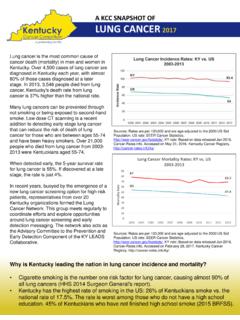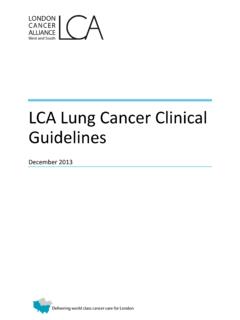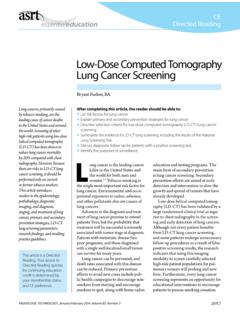Transcription of RR833 - The joint effect of asbestos exposure and smoking ...
1 Health and Safety Executive The joint effect of asbestos exposure and smoking on the risk of lung cancer mortality for asbestos workers (1971-2005) Prepared by the Health and Safety Laboratory for the Health and Safety Executive 2011 RR833 Research Report Health and Safety Executive The joint effect of asbestos exposure and smoking on the risk of lung cancer mortality for asbestos workers (1971-2005) Gillian Frost Health and Safety Laboratory Harpur Hill Buxton Derbyshire SK17 9JN The Great Britain asbestos Survey was established in 1971 to monitor the long-term health of asbestos workers. Descriptive statistics and mortality of the cohort have been reported previously (Harding & Wegerdt, 2006; Harding & Frost, 2009). The objectives of the analysis undertaken for this report were: n to investigate if asbestos exposure increased lung cancer mortality risk in never smokers; n to determine if the risk of lung cancer mortality reduces following smoking cessation for asbestos workers; and n to examine the interaction between exposure to asbestos and smoking on lung cancer mortality risk.
2 This report and the work it describes were funded by the Health and Safety Executive (HSE). Its contents, including any opinions and/or conclusions expressed, are those of the authors alone and do not necessarily reflect HSE policy. HSE Books Crown copyright 2011 First published 2011 You may reuse this information (not including logos) free of charge in any format or medium, under the terms of the Open Government Licence. To view the licence visit , write to the Information Policy Team, The National Archives, Kew, London TW9 4DU, or email Some images and illustrations may not be owned by the Crown so cannot be reproduced without permission of the copyright owner. Enquiries should be sent to ACKNOWLEDGEMENTS We would like to thank the staff at the Health and Safety Laboratory who work on the asbestos Survey, in particular Anna Buttrill, Claire Collins, Rosemary Gagen-Hill and Carl Gartside.
3 Thanks also go to Anne-Helen Harding of the Health and Safety Laboratory, and Andy Darnton of the Health and Safety Executive for their guidance and assistance during the data analysis and report preparation. We would also like to thank the staff at the National Health Service Central Register and the General Register Office for Scotland for their support. ii CONTENTS LIST OF V LIST OF TABLES .. V LIST OF APPENDICES .. VI EXECUTIVE VII 1 1 2 METHODS .. 2 Study 2 Survey 2 Study follow-up .. 2 Variable definition .. 2 smoking status .. 2 Age started and age stopped smoking .. 4 Other variables .. 4 Statistical 4 3 RESULTS .. 6 Descriptive statistics .. 6 Survey 6 Distribution of workers, deaths and demographic characteristics .. 6 Standardised mortality ratios.
4 7 Poisson regression analyses .. 16 asbestos exposure .. 16 Never asbestos and smoking .. 17 asbestos and smoking interaction .. 30 Attributable fraction 32 4 36 Strengths and limitations .. 36 Descriptive statistics .. 36 asbestos exposure .. 37 Never smokers .. 38 asbestos and 38 asbestos and smoking interaction .. 39 Attributable fraction 40 Conclusions .. 40 41 5 47 iii LIST OF FIGURES Figure 1 Distribution of participants by smoking status, and age and calendar period at examination (1971-2005) .. 14 Figure 2 Standardised mortality ratios for lung cancer mortality among male asbestos Figure 3 Relative risks of lung cancer mortality by asbestos exposure variables, Figure 4 Relative risks of lung cancer mortality by smoking variables, estimated using Figure 5 Relative risks of lung cancer mortality among former smokers by smoking workers, by smoking status at the final examination (1971-2005).
5 15 estimated using Poisson regression .. 20 Poisson regression .. 24 variables, estimated using Poisson 29 LIST OF TABLES Table 1 Number of participants who changed smoking status during the study period and the nature of the change (1971-2005).. 3 Table 2 Distribution of workers, person-years at risk and deaths by country of residence, period of employment, length of time in the survey, smoking status, and industrial sector (1971-2005) .. 8 Table 3 Distribution of workers, person-years at risk and deaths by year of birth, age at first exposure , year of first exposure , length of occupational exposure to asbestos , time since first exposure , and time since last exposure (1971-2005).. 9 Table 4 Distribution of current smokers, person-years at risk and deaths by age started smoking , packs smoked per day, smoking duration and total smoking exposure (1971-2005).
6 11 Table 5 Distribution of former smokers, person-years at risk and deaths by age started smoking , packs smoked per day, smoking duration, total smoking exposure , age stopped smoking and time since smoking cessation (1971-2005) .. 12 Table 6 Standardised mortality ratios for lung cancer among asbestos workers, by smoking status at the last examination and gender (1971-2005) .. 15 Table 7 Standardised mortality ratios for lung cancer among male asbestos workers Table 8 Risk of lung cancer mortality among all workers, adjusted for age, calendar Table 9 Risk of lung cancer mortality among all asbestos workers in the final Poisson Table 10 Risk of lung cancer mortality among never smokers, adjusted for age, adjusted for smoking status at the last examination (1971-2005) .. 15 period, sex and smoking status using Poisson regression.. 19 regression model for asbestos exposure .
7 21 calendar period, sex and smoking status using Poisson 22 Table 11 Risk of lung cancer mortality among former and current smokers, adjusted for age, calendar period, sex, smoking status and asbestos exposure using Poisson 23 Table 12 Risk of lung cancer mortality among former and current smokers relative to never smokers, adjusted for age, calendar period, sex, smoking status and asbestos exposure using Poisson regression .. 25 Table 13 Risk of lung cancer mortality among former and current smokers in the final Poisson regression model for smoking exposure .. 26 iv Table 14 Risk of lung cancer mortality among former smokers relative to the lowest level of each variable, never smokers and current smokers, adjusted for age, calendar period, sex and asbestos exposure using Poisson 27 Table 15 Risk of lung cancer mortality among former smokers, with sick-quitters removed and adjusted for age, calendar period, sex and asbestos exposure using Poisson regression.
8 28 Table 16 Multiplicativity index (V) and synergy index (S) estimated using relative risks adjusted by age, calendar period, sex and main 31 Table 17 Multiplicativity index (V) and synergy index (S) estimated combining never- smokers with former smokers who had stopped smoking for more than 40 years, using relative risks adjusted by age, calendar period, sex and main 31 Table 18 Percentage attributable risks from smoking and asbestos exposure among the asbestos 33 Table 19 Percentage attributable risks from smoking and asbestos exposure , estimated combining never smokers with former smokers who had stopped smoking for more than 40 34 Table 20 Estimation of the attributable fraction for lung cancer mortality due to asbestos exposure among male asbestos workers (1971-2005).. 35 Table 21 Estimation of the population attributable fraction for lung cancer mortality due Table 22 Factors to adjust expected lung cancer deaths of British males for smoking to asbestos exposure among males in Great Britain (1986-2005).
9 35 42 Table 23 Poisson distribution 95% confidence limits .. 43 Table 24 Relative risks estimated using Poisson regression (R1, R2, R3, R4) and the population distribution of 45 LIST OF APPENDICES Appendix 1 Statistical methods .. 42 v vi EXECUTIVE SUMMARY Objectives The Great Britain asbestos Survey was established in 1971 to monitor the long-term health of workers in the asbestos industry. Both asbestos exposure and cigarette smoking are recognised risk factors for lung cancer mortality. However, the exact nature of the interaction between the two is still debated. The objectives of the analysis undertaken for this report were: To investigate if asbestos exposure increased lung cancer mortality risk in asbestos workers who have never smoked; To determine if the risk of lung cancer mortality reduces following smoking cessation for asbestos workers; and To examine the interaction between exposure to asbestos and smoking on lung cancer mortality risk.
10 Main Findings There were 1,878 deaths from lung cancer among 98,912 asbestos workers who were followed-up for a total of 1,780,233 person-years. Over 50% of participants were smokers at the time of their last examination, with almost 45% of current and former smokers classed as heavy smokers ( smoking more than 20 cigarettes a day). Both were higher than the percentage in the national population. Even after adjustment for smoking status, the mortality due to lung cancer for male asbestos workers was significantly higher than the national population. Just 2% of lung cancer deaths occurred in asbestos workers who had never smoked. Overall, lung cancer mortality for never smokers who worked in the asbestos industry was higher than never smokers in the national population, but the difference was not statistically significant.














